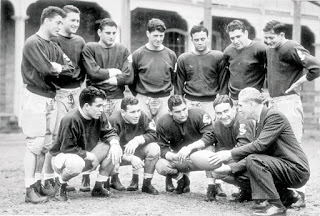What's this? Oh, that's
right - it's footage of
my GRANDFATHER
from the SCU vs. LSU Sugar Bowl
of 1937.
"Santa Clara took the lead on a 27-yard pass play from
Falaschi to MANNY GOMEZ"
click and watch this 2 minute video.
So
awesome.
my grandpa is on the bottom right with his face parallel to the camera
and here he is again on the bottom left - dark and handsome (he was Mexican)
Here's the article by Chuck Hildebrand:
On
New Year’s Day 1937, a team from a little Jesuit school in the Santa
Clara Valley stunned the sports world with an upset that won them the
Sugar Bowl. And put their home on the map.
The 47 Santa Clara football players and their entourage weren’t sure
what was in store at the other end of the line when their Southern
Pacific Bronco Special pulled out of the Santa Clara train station the
day after Christmas 1936. But they knew who they were and whence they
had come: through a season that, by the end of November, was 7-0 and had
them ranked fifth in the Associated Press college football poll,
introduced that fall. They beat Stanford, Auburn, and rival St. Mary’s.
And on Dec. 4, they accepted a bid to play No. 2-ranked Louisiana State
University in the Sugar Bowl at New Orleans’ Tulane Stadium."There was no question we thought we could win the game ...It was virtually a home game for the Tigers; oddsmakers favored LSU 4-to-1. The LSU program had been a public plaything of Louisiana Gov. Huey Long before his assassination in 1935: He’d hired and fired coaches, involved himself in recruiting—even tried to dictate play calls. He devoted enormous state resources to strengthening the university. One result: The LSU line averaged 212 pounds—25 pounds more than Santa Clara’s.
We were good, and we knew it."
The Broncos were virtually unknown in the football-loving East, Midwest, and South. An AP preview story on the eve of the Sugar Bowl included multiple references to the “Bronchos.” Most Santa Clara players came from first- or second-generation immigrant Bay Area families and regarded their football experiences as extensions of their working-class backgrounds. In the midst of the Depression, few of them could have considered college had it not been for their football skills. They played as if far more than the outcome of a game was at stake.
They also had Coach Buck Shaw. He drilled his men in “moving your feet, keeping your balance, things like that,” said center Phil Dougherty ’37.
They were smaller but faster.
“There was no question we thought we could win the game,” teammate Jesse Coffer ’37 said. “We were good, and we knew it.”
 Game on
Game on
The teams took the already muddy field in a steady drizzle before a
capacity crowd of 42,000 at Tulane Stadium. One surprise for the
Broncos: While Huey Long and LSU football were deified in rural
Louisiana, the Crescent City was still a Tulane town, and a large
segment of the throng was there to jeer LSU and cheer for its
opposition. Fans of sister Jesuit school Loyola University of New
Orleans were on Santa Clara’s side, too.At a time before unlimited substitution was allowed, Shaw predicated playing time mainly on defensive skills at three of the four backfield positions. But he had one generalist, Nello Falaschi ’37, who never left the field, and was both the face and the personality of the 1936 Broncos.
Falaschi returned the opening kickoff to the Bronco 41. Teams exchanged punts. A few minutes later, fullback Chuck Pavelko ’37 took a snap from center, feinted left, shook an LSU tackle, and ran 13 yards to the LSU 31. Two plays later, with the ball still on the 31, Pavelko took a snap, pretended to burrow into the line, raised up and flipped a lateral to Falaschi, who then hit wide-open halfback Manny Gomez ’37 with a touchdown pass that gave Santa Clara a 7-0 lead.
 |
| Relive the game: Watch the Broncos in the 1937 Sugar Bowl. |
 |
| Meet the team: See historic photographs. |
“When we got to the dressing room,” Al Wolff ’38 recalled, “there were dozens of shoes sent over by Loyola, just scattered around the floor. The coaches said, ‘Find a pair that fits and put ’em on. Then we changed into our practice uniforms for the second half, and we were ready to play again.”
The defense took over in the second half. LSU managed only 44 rushing yards in the game, and went 25 game minutes without registering a first down during one stretch. A 35-yard interception return by Gomez gave Santa Clara the ball at the LSU 15 midway through the third quarter, and on first and goal from the 4, end Frank “Mississippi” Smith ’37 took a handoff on an end-around and scored to give Santa Clara a 21-7 lead. LSU scored on the second play of the fourth quarter but never seriously threatened to score again. The final score was 21-14.
The ride home was a festive one indeed—so much so that, celebrating along the way, a few of the players even spent a night in jail in Juárez.*
Seventy-five years later, there are only a few of the ’37 Sugar Bowl Broncos left. Chuck Pavelko, now 96, lives in Del Mar. Al Wolff, now 94, lives in Santa Barbara. Wolff sums up that era so: “Football put Santa Clara University on the map.”




No comments:
Post a Comment